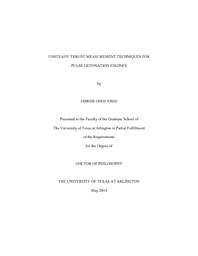
ATTENTION: The works hosted here are being migrated to a new repository that will consolidate resources, improve discoverability, and better show UTA's research impact on the global community. We will update authors as the migration progresses. Please see MavMatrix for more information.
Show simple item record
| dc.contributor.author | Joshi, Dibesh Dhoj | en_US |
| dc.date.accessioned | 2014-07-14T20:33:51Z | |
| dc.date.available | 2014-07-14T20:33:51Z | |
| dc.date.issued | 2014-07-14 | |
| dc.date.submitted | January 2014 | en_US |
| dc.identifier.other | DISS-12647 | en_US |
| dc.identifier.uri | http://hdl.handle.net/10106/24503 | |
| dc.description.abstract | Thrust is a critical performance parameter and its correct determination is necessary to characterize an engine. Many conventional thrust measurement techniques prevail. However, further developments are required for correct measurement of thrust in the case of a pulse detonation engine (PDE), since the entire thrust generation process is intermittent. The significant effect of system dynamics in the form of inertial forces, stress wave propagation and reflections initiated in the structure due to detonations and pulse-to-pulse interaction in a fast operating PDE further complicate the thrust measurement process. These complications call for a further, detailed study of the unsteady thrust characteristics. A general approach was first developed to recover actual thrust from the measured thrust generated by the PDE. The developed approach consisted of two steps. The first step incorporated a deconvolution procedure using a pre-established system transfer function and measured input to reconstruct the output yielding the deconvolved thrust. The second step accounted for inertial forces through an acceleration compensation procedure. These two steps allowed the actual thrust to be determined. A small scale PDE operating at 10 and 20 Hz with varied filling fractions and mixture equivalence ratios was used for the experimental application of the general approach. The analytical study of gas dynamics in the PDE while in operation and the measured pressure histories at the exit of the engine allowed the generated thrust during a cycle to be determined semi-empirically. The thrust values determined semi-empirically were compared against the experimental results. A dynamical model of the PDE was created for the study of the unsteady thrust characteristics using finite element analysis. The results from finite element analysis were compared against semi-empirical and experimental results. In addition, finite element analysis also facilitated to numerically determine the unsteady thrust generated by the PDE at higher operating frequencies of 50 and 100 Hz. The actual thrust estimated experimentally, semi-empirically and numerically were expressed in the form of specific impulse for comparison. The results obtained via semi-empirical method and finite element analysis were found to be in good agreement with each other. However, the results obtained experimentally were slightly lower than the other two. Finally, the results obtained in this research work were also compared against the findings reported in literature. The comparison gave satisfying results.The developed general approach used to recover actual thrust generated by a PDE was also used to recover actual aerodynamic drag experienced by a blunt nose cone model in a nominal Mach 8-9 flow. The limited validation against modified Newtonian theory was provided as the results obtained after applying the developed approach matched the predicted values. | en_US |
| dc.description.sponsorship | Lu, Frank | en_US |
| dc.language.iso | en | en_US |
| dc.publisher | Aerospace Engineering | en_US |
| dc.title | Unsteady Thrust Measurement Techniques For Pulse Detonation Engines | en_US |
| dc.type | Ph.D. | en_US |
| dc.contributor.committeeChair | Lu, Frank | en_US |
| dc.degree.department | Aerospace Engineering | en_US |
| dc.degree.discipline | Aerospace Engineering | en_US |
| dc.degree.grantor | University of Texas at Arlington | en_US |
| dc.degree.level | doctoral | en_US |
| dc.degree.name | Ph.D. | en_US |
Files in this item
- Name:
- Joshi_uta_2502D_12647_2.pdf
- Size:
- 12.94Mb
- Format:
- PDF
This item appears in the following Collection(s)
Show simple item record


